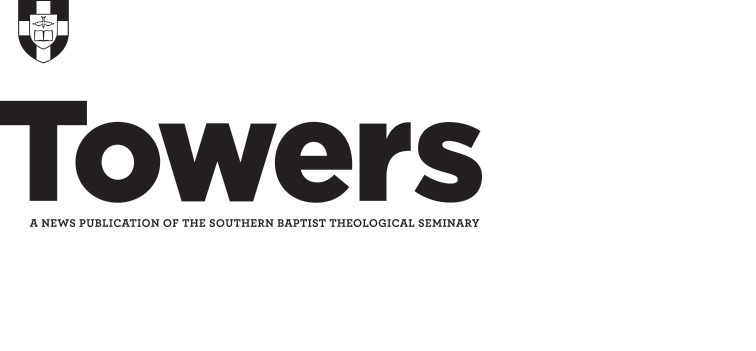EDITOR’S NOTE: Below, Gregg R. Allison, professor of Christian theology at Southern Seminary, talks with Towers editor Andrew J.W. Smith about his new book, 50 Core Truths of the Christian Faith.

AJWS: This book seeks to make Christian doctrine more readily available — for students and also for educators, Sunday school teachers, and high school Bible teachers. Why is this kind of book necessary?
GA: There are a lot of good theology books that have been written and are being written. Often they’re pretty lengthy and go into a lot of depth. There are some that are more basic — more outline, more overview — but the whole idea was to make a user-friendly book on doctrine. Baker Books [the publisher] has a series called Teach the Text. It walks through how to preach and teach each of the books of the Bible. It’s very user-friendly in its outline form. So one of the editors at Baker reached out to me and said, “Take a look at this Teach the Text. This is how we do commentaries. Can you do something like this for doctrine?” So I proposed this concept and they went with it. I want this book to make doctrine very accessible without going into a lot of detail. Each chapter is about 2,200 words, or seven pages.
AJWS: What’s the best way to use this book?
GA: At the end of each chapter in the book, I also list resources. So I would refer to Grudem’s Systematic Theology for the doctrine of the Trinity, the doctrine of sin, for the doctrine of Christ. That would provide the bulk of the actual doctrine itself that a Sunday school teacher or a high school teacher would need. My book is basically an outline of how to go about learning this and teaching it. It’s really slimmed down, it’s really lean. If people have read Grudem’s Systematic Theology or Erickson’s Christian Theology, they’ll find there’s nothing new in mine other than the way it’s organized. I’m providing an outline, a skeleton, a framework for people, and as they want to explore these issues in more detail, they’re going to have to look elsewhere. In an hour, you can cover the doctrine with this book, but if you have two hours or four hours, you could do it in more detail with another text. But just simply working off the seven pages in this book, you have an hour’s worth of material. That was the idea.
AJWS: You organize each chapter the same way: understanding doctrine, enacting doctrine, and teaching doctrine. How did you settle on that structure for each chapter?
GA: The chapters are modeled pretty much after the Teach the Text series. That’s how they did it. I like that framework. First, we have to understand it, and then we will live it. Then I want them to be able to teach it. So the idea is that doctrine is believed, it’s lived, it’s confessed, and it’s taught. I build on our basic understanding of the doctrine of the Trinity or the doctrine of Christ, then explain how we live the reality of the triune God and who Christ is for us. Finally, I show how we teach people about the triune God and about the person of Christ — fully God and fully man.
I also have a section in there where I list common questions and problematic issues from the point of view of a participant in your class. I’ve been teaching this for 24 years, and inevitably these questions or comments will come up. There are things your students are thinking about. When you say, “Are there any comments or questions?” They’re going to raise their hand and say, “Here’s my comment: The doctrine of the Trinity is just too hard.” Or, “How can God be all-good, all-powerful, and yet there be evil in the world?” So I’m just tipping off teachers and educators who use this as a guide. Some of the answers are found as you go through the book. Others you’re going to have to solve on your own, I’ve only got 2200 words. So look at Erickson, look at Grudem, look at the Evangelical Dictionary of Theology — use these other resources. But be prepared. Get ready to answer the questions, because your students are going to ask!
AJWS: How would you pitch to someone who doesn’t think theology is necessary that they need to understand basic Christian doctrine?
GA: I would very tactfully say: Whether you realize it or not, you have a theology already in mind whenever you read the text of Scripture. You already have basic notions about God, his attributes, his ways in this world, what Christ has done, what the gospel is, what the church is. So you’ve already got a brain, a mind full of theological ideas, concepts, and frameworks. No one comes to the Bible without a theology already developed. Now if you have a bad theology, it often inhibits you from reading the Bible properly. If you have a good theology, it will push you and prompt you to read the Bible properly. So what this book and others prompt you to do is to have a good theological framework so that as you read Scripture, you’ll see the riches and wealth of Scripture in a way you’ve probably never seen before.
AJWS: Would it be fair to say everybody systematizes, whether they’re trying to or not?
GA: Yes, everybody has a theological framework. It’s either good or bad. This book is designed to help you have a good theological framework, and that helps you read the Bible properly. How do cults develop? They have bad theology, and then they find passages in Scripture that support their bad theology. That fuels and causes their bad theology to grow, and they just perpetuate it.
AJWS: How do we learn not to merely understand the theological content of a sermon, but enact it in our lives?
GA: When we’re in church, when we gather with other believers, the sermon is a vital part of the worship service. From a Protestant perspective, we could say it’s one of the two marks of the church. We should be attentive to the reading of the Word and the preaching of the Word. But we should never see the other elements prior to or following preaching as inferior to the sermon. We should engage in a community of believers who genuinely worship the Lord. We should enjoy not only the reading and preaching of the Word but the singing of hymns, responsive reading of the Psalms, confessing our sins, being thankful for the forgiveness of sins, the Lord’s Supper, regularly baptizing people, calling people to the mission of the church. I think we should engage with all the elements of the worship service.
Also, when we hear a sermon, we often have really good intentions to put the sermon into practice. But within three hours or three days, that good intention has not translated into action. We applied it for a day, but then it’s gone. So, we need to help our people move beyond good intentions to “a character of discipline” (that expression is not new with me) by which we don’t just intend to apply but we actually do apply.
To help us, it’s good to be in community. In community groups, we are reminded in the middle of the week of what we committed to on Sunday. You’ve got good intentions; how are you actually living it out during the week? In community, we are exhorting and encouraging one another to live it out. That’s so important.
AJWS: For pastors who want to integrate more doctrine into their sermons: How can they do that without making a sermon a theology lesson?
GA: So don’t preach systematic theology. Preach the Bible, and draw people’s attention to the rich doctrines that Paul or Peter or Isaiah is unfolding in that text. That’s how I would always do expository preaching. As you’re working through Ephesians 2, preach the reality of total depravity. Galatians 5, preach walking in the Spirit. So, in addition to explaining what the meaning of the text is, here is a rich truth from God’s Word that should frame everything that we do.





